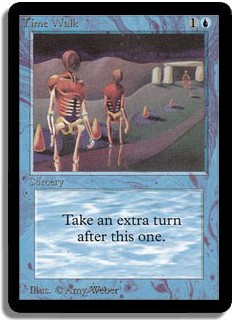Are you a Quiet Speculation member?
If not, now is a perfect time to join up! Our powerful tools, breaking-news analysis, and exclusive Discord channel will make sure you stay up to date and ahead of the curve.
This summer is absurd. Modern Horizons 2 has just hit the street, and Wizards is already previewing Adventures in the Forgotten Realms. Or technically, this is Wizards continuing to preview Adventures in the Forgotten Realms because there were initial teasers alongside the first MH2 spoilers. It's way too much, way too fast, and is deeply unfair to my wallet. And that's not to mention how all this coincides with the Steam Summer Sale.

The other annoying part is that many AFR cards are already obsolete and haven't even been released. Several cards from the initial teaser are Modern playable. However, MH2 featured better versions of said cards. While interesting for their Standard implications, it does mean that they're unlikely to make it in Modern except as budget options. Which is odd considering how they did look targeted at Modern, and it makes me wonder how well Wizards actually coordinates their card designs. But the most recently spoiled cards (at time of writing, anyway) make up for AFR being superseded by MH2. The dungeons have interesting play implications and could potentially make it in Modern. The catch is that they'll need help from the rest of the set.
Venturing Into the Dungeon
The dungeons were revealed last Thursday. They are three not-exactly cards, not-exactly tokens representing very famous dungeon crawls from Dungeons and Dragons. Which will mean something for some people and nothing to others. I'm somewhere in between as a general-purpose nerd that doesn't play D&D but knows people who do. What matters to me is that every player has access to the dungeons at all times because dungeons don't go into decks or sideboards. Instead, they're to be treated like tokens in that they just sit alongside your sideboard until needed. When a dungeon is played, it moves from outside the game into the command zone, which to my knowledge has never happened before outside of Commander.

Once there is a dungeon in the command zone, the goal is to venture through that same dungeon until the end. To do that, players have to venture into the dungeon, an action triggered by certain AFR cards. Based on the cards revealed so far, venture into the dungeon appears to be like scry in normal sets: something tacked onto a normal card as an extra effect. Importantly, the player venturing chooses which dungeon to venture into, and which adjacent room of that dungeon to move into if at a crossroads. Once you reach the end, the dungeon is considered complete and exits the command zone.
The Fear
 Currently, we know next to nothing about how venture will play out. A few enablers and one non-dungeon payoff are all that's been spoiled as I'm writing this sentence. However, that hasn't stopped players from declaring that the sky is falling. Because nothing ever does. I was prepared to just dismiss these concerns until a player at last week's FNM started arguing that dungeons are the companions all over again. His argument is that dungeons are another set of cards that take up no deck space and are always "in hand" but are actually impossible to interact with and provide constant value. Which requires players to have dungeons or die. Plus, who knows what other dungeons are lurking and how busted they'll be. While said player is prone to trollish outbursts, there have been some expressing similar concerns in a more sane fashion. Thus, it is a concern worth addressing.
Currently, we know next to nothing about how venture will play out. A few enablers and one non-dungeon payoff are all that's been spoiled as I'm writing this sentence. However, that hasn't stopped players from declaring that the sky is falling. Because nothing ever does. I was prepared to just dismiss these concerns until a player at last week's FNM started arguing that dungeons are the companions all over again. His argument is that dungeons are another set of cards that take up no deck space and are always "in hand" but are actually impossible to interact with and provide constant value. Which requires players to have dungeons or die. Plus, who knows what other dungeons are lurking and how busted they'll be. While said player is prone to trollish outbursts, there have been some expressing similar concerns in a more sane fashion. Thus, it is a concern worth addressing.
The Reality
In my view, though, there is little reason to believe that dungeons will be at all dangerous. They may not even see Modern play. I'll start with the easiest concern to address: there are no more dungeons. Period. The three Wizards revealed are all that were made. Mark Rosewater confirmed this, and added  that initially there was only one dungeon. For once, it seems Wizards didn't want to go HAM on their first attempt at a mechanic, and deliberately restrained themselves. Which doesn't preclude more in the future, but it will be a distant one.
that initially there was only one dungeon. For once, it seems Wizards didn't want to go HAM on their first attempt at a mechanic, and deliberately restrained themselves. Which doesn't preclude more in the future, but it will be a distant one.
Secondly, while it's true that dungeons are available at all times just like pre-nerf companions, the comparison ends there. The fact that every player always has access to the dungeons at all times is irrelevant: they don't do anything on their own. The only way to get anything from them is another card's venture trigger. The companions were useful because they were functionally like an eighth card in every opener. But dungeons are just an incidental payoff for other cards that generate small but increasing effects the further into the dungeon you venture, which may indeed be worse than a scry in many scenarios. It might even prove weaker than learn.
Seeking Treasure in Darkness
 That doesn't mean that dungeons are unplayable. Incremental but building advantage is definitely playable; just look at Search for Azcanta or most planeswalkers. The key question is whether there are venture cards that fit into Modern. Just being a decent venture enabler is not enough; the card needs to be Modern playable in a vacuum. Learn is the latest example of this truism, but far from the only one. Only four venture cards have been spoiled so far, and two are clearly meant for Limited only. Of the remaining two, Nadaar, Selfless Paladin is borderline, leaning toward unplayable. A 3/3 for three with vigilance is not Modern playable. One that has an enters the battlefield/attacks trigger might be in the right deck and/or metagame. I can't guess which.
That doesn't mean that dungeons are unplayable. Incremental but building advantage is definitely playable; just look at Search for Azcanta or most planeswalkers. The key question is whether there are venture cards that fit into Modern. Just being a decent venture enabler is not enough; the card needs to be Modern playable in a vacuum. Learn is the latest example of this truism, but far from the only one. Only four venture cards have been spoiled so far, and two are clearly meant for Limited only. Of the remaining two, Nadaar, Selfless Paladin is borderline, leaning toward unplayable. A 3/3 for three with vigilance is not Modern playable. One that has an enters the battlefield/attacks trigger might be in the right deck and/or metagame. I can't guess which.
 Ellywick Tumblestrum, on the other hand, has potential. And a very silly name. Which D&D bards are legendary for, so at least it's a lore win. More importantly, her -2 loyalty ability is just right for Modern: digging for creatures sees play in plenty of contexts. For four mana, Collected Company finds two (smallish) creatures and puts them into play, which is much better than just finding one. However, Ellywick can find any creature, with a bonus for legendary ones. And will do so twice on her own. The first and third abilities combine nicely, and venturing through the dungeon while getting a new effect each turn is not the worst. So it could happen.
Ellywick Tumblestrum, on the other hand, has potential. And a very silly name. Which D&D bards are legendary for, so at least it's a lore win. More importantly, her -2 loyalty ability is just right for Modern: digging for creatures sees play in plenty of contexts. For four mana, Collected Company finds two (smallish) creatures and puts them into play, which is much better than just finding one. However, Ellywick can find any creature, with a bonus for legendary ones. And will do so twice on her own. The first and third abilities combine nicely, and venturing through the dungeon while getting a new effect each turn is not the worst. So it could happen.
The Key
More importantly, Ellywick and Nadaar say a lot about how venturing is meant to play out. Both of them are only capable of venturing once per turn, meaning on their own they're not really going to get through a single dungeon in a typical game. They're similar to Sagas in that respect. Most games aren't going to last past turn 6, which is within the minimum time for both enablers to run the Lost Mine or Tomb, but not the Dungeon of the Mad Mage. And that also assumes that neither card has died and there was no reason to do something else with Ellywick.
 However, that also tracks with the lore. Entering a dungeon on your own is suicide; that's why parties exist. Venture does stack, so if multiple enablers are playable in the same deck, it may be possible to blitz the dungeons. Which begs the question whether it's worthwhile to actually delve any of them.
However, that also tracks with the lore. Entering a dungeon on your own is suicide; that's why parties exist. Venture does stack, so if multiple enablers are playable in the same deck, it may be possible to blitz the dungeons. Which begs the question whether it's worthwhile to actually delve any of them.
Since I have no idea how quickly it will be possible to venture through the dungeons, I'll discuss the two extremes. The slowest will be a single room per turn; the fastest is blazing through in one turn. The low end is absolutely plausible while the upper end is pretty unlikely, but not impossible. It's far more likely that a deck that wants to venture as a game plan or even as incidental value will be inconsistent about the speed, but I can't know that while I can know the extreme cases.
Lost Mine of Phandelver
 Of the dungeons, the Lost Mine of Phandelver is the best for starting out. Scry 1 is much better more of the time than losing or gaining a single point of life. This indicates that this dungeon is designed with incidental value in mind and that Wizards expects players to stroll rather than barrel through. And for the strolling player, there's some decent value to be had. Scry 1 is decent, though not especially powerful, as shown by Opt. From there the path really depends. The drain in the Dark Pool is a good failsafe condition with the +1/+1 counter option being the most powerful. The main problem is that the big payoff is a cantrip. Not horrible, but it really makes me wonder if this dungeon was worthwhile.
Of the dungeons, the Lost Mine of Phandelver is the best for starting out. Scry 1 is much better more of the time than losing or gaining a single point of life. This indicates that this dungeon is designed with incidental value in mind and that Wizards expects players to stroll rather than barrel through. And for the strolling player, there's some decent value to be had. Scry 1 is decent, though not especially powerful, as shown by Opt. From there the path really depends. The drain in the Dark Pool is a good failsafe condition with the +1/+1 counter option being the most powerful. The main problem is that the big payoff is a cantrip. Not horrible, but it really makes me wonder if this dungeon was worthwhile.
Conversely, speed-running the Lost Mine in a single turn is much better. The main reason is that the first and final ability aggregate into Opt, a very Modern-worthy card. The question is which middle path to take. The best value in a vacuum is to take the left path, which would result in a 2/2 goblin with Opt. That's not a bad outcome assuming that not a lot of mana was spent achieving said outcome. This is definitely what aggro wants to do, though they'd probably put the counter on anything other than the token given a choice. Slower decks could potentially benefit more from the treasure and nerfing an attacker. Outside of a close race, the Pool's drain is unlikely to be relevant except when there aren't creatures on board. All in all, not a bad dungeon, but it's not particularly inspiring either. A nice, functional 5/10 type dungeon.
Tomb of Annihilation
 This is the dungeon that I expect most players are going to try and blitz. Which makes perfect sense; it's the Tomb of Annihilation! Entering the dungeon hurts all players and continuing on will also hurt, but the harm may be limited to the one doing the venturing. The left path is a decent taxing system for aggro decks, asking the opponent if their precious life points are worth losing cards for. Getting another threat of decent size at the end is quite good too. It's therefore the route I expect most incidental adventurers to take.
This is the dungeon that I expect most players are going to try and blitz. Which makes perfect sense; it's the Tomb of Annihilation! Entering the dungeon hurts all players and continuing on will also hurt, but the harm may be limited to the one doing the venturing. The left path is a decent taxing system for aggro decks, asking the opponent if their precious life points are worth losing cards for. Getting another threat of decent size at the end is quite good too. It's therefore the route I expect most incidental adventurers to take.
The right path is very high risk, but potentially rewarding. What's up for debate is whether it's rewarding enough. It yields the shortest dungeon path of all, but requires Smallpoxing yourself and only yourself. That's a huge ask when the payoff is just a 4/4 deathtouch. Could be worse; it could be the Tomb of Horrors. However, this is also the kind of ability that can be built around. Flagstones of Trokair is a card, and self discard an enabler, as (okay Ernenwein, steel yourself. Ready? *deep breath*) Asmoranomardicadaistinaculdacar (*gasp, pant*) will attest. In a deck that wants to discard its own cards and/or sacrifice its own permanents, Tomb could be an integral strategic option. The horror would just be a bonus in that case. Of all the dungeons, this strikes me as the most constructed-aimed.
Dungeon of the Mad Mage
 I will be stunned beyond words if it is actually possible to blitz Dungeon of the Mad Mage in normal Modern games. It takes seven venture triggers to get to the end! That would require either a huge number of enablers or one that can be activated multiple times a turn. The former would probably win the game on their own while the latter is likely to be targeted at Commander rather than Modern, but we'll see.
I will be stunned beyond words if it is actually possible to blitz Dungeon of the Mad Mage in normal Modern games. It takes seven venture triggers to get to the end! That would require either a huge number of enablers or one that can be activated multiple times a turn. The former would probably win the game on their own while the latter is likely to be targeted at Commander rather than Modern, but we'll see.
Should players make it though, this is by far the most profitable dungeon, which makes perfect sense: higher investment, higher reward. However, until level five, all the rewards are mediocre at best. Gaining a life, making a treasure, and scry 1 then scry 2 aren't terrible, but you'd expect so much more for the effort needed to venture that far into the dungeon. At level 5, getting a Light Up the Stage or Raise the Alarm is pretty good, and should the final room be reached, the Dungeon is just absurd. However, seven rooms is a huge investment and unless the enablers are really good and there are a lot of them, I don't see anyone actually making it to the end in a normal Modern game.
Caution Is Rewarded
The dungeons are interesting and are potentially Modern playable, the Tomb of Annihilation in particular. However, it will take aggressively-costed or already playable enablers to make it happen. For which we just have to wait and see. Nonetheless, I feel very confidant saying that the odds of another companion situation are basically nil.





